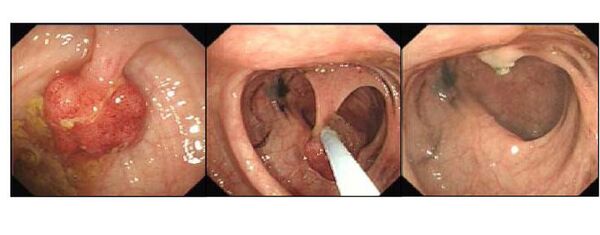Colonoscopic examination
Colonoscopic examination or colonoscopy is an endoscopy examination of the digestive tract. It is basically a kind of gastroscopy. In contrast, during colonoscopy, the endoscopic device is inserted into the rectum and it examines the entire ileum and terminal ileum.
Principle[edit | edit source]
A thin, flexible tube of the endoscope is inserted into the patient's rectum and the doctor carefully inserts it further and further. At the end of the hose is a small video camera that projects an image of the bowel cavity onto the screen where the doctor sees it. Using the control apparatus, the end of the endoscope can be rotated in various ways, and thanks to this, the endoscope can be stretched along the entire length of the uneven large intestine.
In addition, the endoscope allows the use of small ticks, which can painlessly cleave a small sample of mucosa (biopsy), which can then be sent for the histological examination.
The colonoscopy tube also allows the introduction of various tools that can be used to perform simple medical procedures - perhaps the most common procedure is the removal of the polyp or polypectomy.
Preparation[edit | edit source]
The patient should not eat the day before the scheduled colonoscopy and should only drink fluids. He should be emptied with empty solution the same afternoon. Isoosmolar solutions, such as Fortrans, Golitela, are used and it is necessary to drink 4 liters of this solution. This causes severe diarrhea, thus clearing the bowel cavity from the stool to make it clearer and more accessible for examination.
Part of the preparation for this procedure is the temporary withdrawal of anticoagulants (especially warfarin). This is not important for the colonoscopy itself, but a possible finding and subsequent cutting of the polyp would be problematic - bleeding from the wound would be difficult or impossible to stop due to anticoagulant warfarin. Warfarin has a longer half-life and is therefore discontinued about 5 days before the procedure. However, anticoagulants should only be discontinued after a consultation with your doctor!
Just before colonoscopy, the patient is usually given a sedative injection, so the patient should not drive a motor vehicle for 24 hours after the procedure.
Importance[edit | edit source]
Examination of the colon wall along with sampling is important for the diagnosis of colorectal cancer, diverticulosis, ulcerative colitis and many other diseases. . The polyp removal is an elegant prevention of colon cancer, which is often the result of polyps. The most common reason for colonoscopy is the finding of blood in stool.
Complications[edit | edit source]
Colonoscopy is a very safe examination. A rare complication is the rupture of the intestinal wall by an endoscope. It is slightly more common than esophageal wall rupture in gastroscopy. It is a less serious condition than an esophageal rupture, but it must be treated surgically. A limitation of colonoscopy to the large intestine is also a certain problem. The small intestine cannot be examined by colonoscopy.
Benefits[edit | edit source]
The big advantage is that the doctor sees the condition of the mucosa "with his own eyes", that he can take samples and remove polyps. The patient is not exposed to any harmful X-rays during this examination.
Links[edit | edit source]
Related articles[edit | edit source]
External links[edit | edit source]
- ŠTEFÁNEK, Jiří. Medicína, nemoci, studium na 1. LF UK [online]. [cit. 24.03.2010]. <https://www.stefajir.cz/>.

